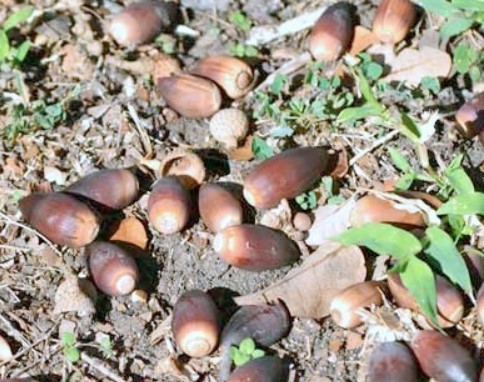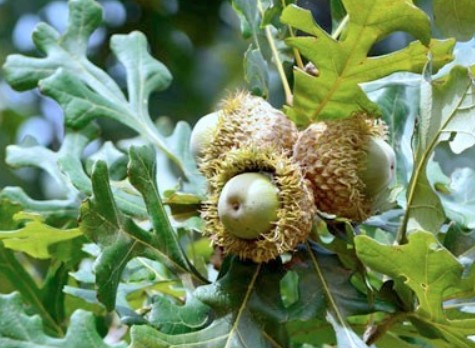From Mighty Oaks Come Mighty Irritating Acorns


Published September 29, 2012, By BILL SEAMAN
In addition to crisp mornings and cool northerly breezes, the arrival of fall is signaled by the plunk of acorns hitting the roof or the pings as they bounce off a metal lawn chair. In years when trees produce a heavy crop of seeds, sidewalks quickly become an obstacle course, and lawns become the bane of barefoot children. For a few weeks, that majestic Oak becomes a major pest.
Numerous factors play into why Oak trees produce an excessive number of acorns. As a plant group, Oaks are genetically diverse. Live Oaks prove the point. Seedlings from the same tree can grow into diversely different trees, each having its own outward personality. Leaf size and shape, along with overall tree form, will vary among the seedlings. The genetic predisposition to produce acorns can vary, too. While a propensity to bloom is highly desirable in Magnolias, Redbuds, and other flowering trees, the same characteristic in Oaks results in an annoying dusting of discarded tassels in the spring, and a crop of acorns heavy enough to break limbs as nutlets reach their maximum moisture content in August and early September.
Additionally, there is the horticultural phenomenon of the “mast year.” Oaks, along with Pecans, Walnuts and other nut producing trees, occasionally produce a crop, or mast, that may exceed the usual yearly production by five or ten times. A single mature Oak may produce 1,000 pounds of acorns in a mast year. The crop so far exceeds what squirrels hoard and other wildlife consume that the remainder spoils and slowly becomes part of the organic layer of leaf litter. Mast years can be a boon to those gardeners anticipating the year’s pecan crop. However, when Oaks flaunt the quirky event, the same gardeners mumble under their breath as they repeatedly sweep acorns off their patios and empty out the rain gutters.

These escarpment Live Oak acorns provide a valuable food source for squirrels and other wildlife. Those acorns not consumed will germinate or become part of the leaf litter.
Weather may be the dominant factor in determining the size of an acorn crop. Since Oaks depend on wind to move pollen from the male flowers to receptive female flowers, a few consecutive dry and breezy spring days are all that is required. If the same days are still, and rainfall cleans the air of Oak pollen, fewer flowers are pollinated. Perfect weather conditions, from the perspective of acorn production, may be the triggering factor for a mast year -- or good weather may result in an average year of production. A string of calm, rainy spring days or a late, hard freeze may result in no acorns at all.

Shumard Red Oak trees and other Oaks in the Red Oak Group produce acorns on the previous year’s growth.
There is a reason why there are no years of no acorns. Nature, in her genius, endowed the Red Oak Group with a trait reserved for few plants -- biennial fruit. It takes two years for acorns on Red Oaks to mature. Oaks in the White Oak Group produce fruit like most trees -- flowers in the spring and fruit in the fall. Red Oaks break the conventional rule by producing acorns on the previous year’s growth -- flowers in the spring and fruit the next fall. The current year’s pollinated flower serves as an understudy, while the previous year’s flower develops into a viable acorn. Should poor weather conditions result in no current year production, Red Oaks trump the weather by producing acorns pollinated the previous year.

The large Bur Oak tree acorns, and those of other Oaks in the White Oak Group, are produced on the current year’s growth.
Biennial fruit production makes describing the acorns falling from Red Oaks a bit of a conundrum. Would they be this year’s acorns, or last year’s acorns? The point is lost on squirrels, even though they are likely the greatest benefactor of this quirky horticultural characteristic.

